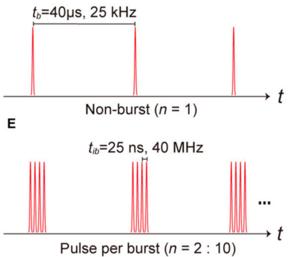
The field of laser technology has witnessed groundbreaking advancements in recent years, particularly in the manipulation and interaction of materials at the nanoscale. Researchers are now harnessing the power of lasers not just for traditional applications, but also for creating intricate structures and patterns that exhibit unique properties. This exciting realm of study is largely focused on the generation of Laser Induced Periodic Surface Structures (LIPSS), which are pivotal in enhancing material functionalities.
Recent publications have shed light on the burst operation of lasers, which enables precise control over energy delivery, thereby influencing the characteristics of the generated LIPSS. The burst operation leverages multiple rapid laser pulses to create high spatial frequency patterns on the material surface, leading to enhanced surface properties such as wettability, adhesion, and optical characteristics. Such patterns can be tailored by varying the pulse energy and duration, giving researchers unprecedented control over material engineering.
Figures illustrating this sophisticated process provide critical context for understanding the underlying mechanisms at play. For instance, a schematic representation elucidates how the cyclical bursts of laser energy impact the material, generating waves of thermal and mechanical energy that engrave the surface. These visual aids bridge theoretical knowledge with practical applications, showcasing the transformative potential of strategic laser manipulation.
The investigation into LIPSS reveals exciting insights, particularly when examining metrics such as height variations, modulation depth, and periodicity in relation to laser settings. Attaching a measure of physical properties to laser parameters allows scientists to quantify how alterations in pulse duration or energy can yield differing structural outcomes. For example, the alignment of LIPSS along various axes and its resultant effects on material performance takes center stage in experimental observations, generating an intricate dance of laser energy and surface topology.
In specific experiments, the heights of LIPSS observed along this directional flow provide vital links to theoretical models that attempt to predict pattern formation. Enhanced modulation depths, as documented in peer-reviewed journals, unveil the relationship between process parameters and surface derivatives. Such discoveries are foundational, as understanding rate of energy deposition and its spatial impacts on the substrate material fosters innovation in multiple fields including optics, photonics, and surface engineering.
Moreover, the examination of periodicity against various laser pulse energies specifically highlights how energy thresholds can affect the resultant surface characteristics. Monitoring these experimental data allows researchers to systematically explore how manipulating energy inputs can lead to optimal results. This meticulous balance of energy and structural integrity speaks to the heart of materials science, combining physics, chemistry, and engineering into cohesive studies that can lead to real-world applications.
Investigating the electron microscopy images of the resulting LIPSS provides concrete evidence of the effectiveness of this novel laser approach. Scanning Electron Microscopy (SEM) images demonstrate the precise, ordered structures created on the material surface, affirming the theoretical models proposed by researchers. Furthermore, two-dimensional Energy Dispersive X-ray (EDX) maps visually represent the elemental distribution across the treated surfaces, highlighting differences that arise from multi-faceted laser interactions over traditional treatments.
The advent of laser-written self-organized nanogratings marks another leap forward in this field. These structures are not only fascinating from a technical standpoint but also possess real potential for applications in sensors, energy harvesting systems, and more. The comparison between nanogratings formed through nonburst and burst laser techniques reveals enlightening information about how varying laser modalities can lead to distinct structural outcomes with different material properties, particularly for innovative applications.
This emerging landscape of laser technology fosters a collaborative effort among researchers, engineers, and industry stakeholders aiming to unlock new capabilities and applications. As scientists plunge deeper into the interconnected mechanics behind laser interactions with matter, the horizon for practical implementation continues to expand, promising advances in fields as diverse as biomedical engineering to renewable energy.
In conclusion, understanding the intricacies of LIPSS formation through advanced laser techniques signifies much more than academic curiosity. These findings have the potential to lay the groundwork for innovative solutions that address contemporary challenges. By navigating this delicate balance of energy, material properties, and structural engineering, we stand at the brink of a technological revolution, driven by the extraordinary capabilities of lasers.
As research continues to evolve in this exciting area, anticipating the future holds immense promise. The intersection of laser physics with material science will likely spur innovations that transform our interaction with everyday materials, yielding not only enhanced performance but also upwards of sustainable solutions to global challenges. The possibilities continue to unfold, with laser technology at the forefront of this transformative wave.
Lastly, the persistent exploration into LIPSS and their broader implications promises a vibrant landscape for future studies. Each breakthrough unveils layers of complexity within the material interaction spectrum, inciting curiosity and ambition among the scientific community. In doing so, we take one step closer to unlocking the potential of material applications that were once constrained by the limits of existing technologies.
Subject of Research: Laser Induced Periodic Surface Structures (LIPSS)
Article Title: Advancements in Laser Technology: Pioneering New Frontiers in Material Engineering
News Publication Date: October 2023
Web References: [Not Available]
References: [Not Available]
Image Credits: [Not Available]
Keywords
Laser technology, LIPSS, burst operation, material engineering, optical properties, nanotechnology, electron microscopy, energy deposition, surface structures.
Tags: burst operation in laser systemsenergy delivery in laser pulsesfemtosecond laser technologylaser induced periodic surface structureslaser pulse duration effectsLIPSS fabrication techniquesmicro and nanofabrication advancementsnanoscale material manipulationoptical characteristics of materialssurface property enhancementtailored laser patternswettability and adhesion improvement





